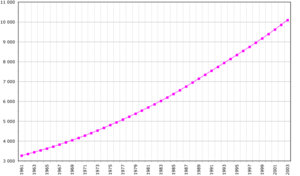Demographics of Senegal
2007 Schools Wikipedia Selection. Related subjects: African Geography
About 70% of Senegal's population is rural. In rural areas, density varies from about 77 per square kilometer (200/mile²) in the west-central region to 2 per square kilometer (5/mile²) in the arid eastern section. About 50,000 Europeans (mostly French) and Lebanese reside in Senegal, mainly in the cities. French is the official language but is used regularly only by the literate minority. Almost all Senegalese speak an indigenous language, of which Wolof has the largest usage. A lot of Senegaleses are emigrated in Europe, particularly in France, Italy and Spain.
Population
- 9,987,494 (July 2000 est.)
- 11,987,121 (July 2006 est.)
Age structure
0-14 years
- 45% (male 2,237,678; female 2,213,632)
- 40.8% (male 2,467,021/female 2,422,385)
15-64 years
- 52% (male 2,501,649; female 2,729,412)
- 56.1% (male 3,346,756/female 3,378,518)
65 years and over
- 3% (male 152,236; female 152,887) (2000 est.)
- 3.1% (male 174,399/female 198,042) (2006 est.)
Population growth rate
- 2.94% (2000 est.)
- 2.34% (2006 est.)
Birth rate
- 37.94 births/1,000 population (2000 est.)
- 32.78 births/1,000 population (2006 est.)
'Death rate
- 8.57 deaths/1,000 population (2000 est.)
- 9.42 deaths/1,000 population (2006 est.)
Net migration rate
0 migrant(s)/1,000 population (2000 est.)
Sex ratio
at birth
1.03 male(s)/female
under 15 years
1.01 male(s)/female
15-64 year
0.92 male(s)/female
65 years and over
1 male(s)/female
total population
0.96 male(s)/female (2000 est.)
Infant mortality rate
- 58.08 deaths/1,000 live births (2000 est.)
- 52.94 deaths/1,000 live births (2006 est.)
Life expectancy at birth
total population
- 62.19 years (2000 est.)
- 59.25 years (2006 est.)
male
- 60.6 years (2000 est.)
- 57.7 years (2006 est.)
female
- 63.82 years (2000 est.)
- 60.85 years (2006 est.)
Total fertility rate
- 5.21 children born/woman (2000 est.)
- 4.38 children born/woman (2006 est.)
Nationality
noun: Senegalese (singular and plural)
adjective: Senegalese
Ethnic groups
Wolof 43.3%, Fula 23.8%, Serer 14.7%, Jola 3.7%, Mandinka 3%, Soninke 1.1%, European and Lebanese 1%, other 9.4%
Religions
Muslim 92%, indigenous beliefs 6%, Christian 2% (mostly Roman Catholic)
Languages
French (official), Wolof, Pulaar, Jola, Mandinka
Literacy
age 15 and over can read and write
total population
33.1%
male
43%
female
23.2% (1995 est.)
- See also : Senegal
Algeria • Angola • Benin • Botswana • Burkina Faso • Burundi • Cameroon • Cape Verde • Central African Republic • Chad • Comoros • Democratic Republic of the Congo • Republic of the Congo • Côte d'Ivoire (Ivory Coast) • Djibouti • Egypt • Equatorial Guinea • Eritrea • Ethiopia • Gabon • The Gambia • Ghana • Guinea • Guinea-Bissau • Kenya • Lesotho • Liberia • Libya • Madagascar • Malawi • Mali • Mauritania • Mauritius • Morocco • Mozambique • Namibia • Niger • Nigeria • Rwanda • São Tomé and Príncipe • Senegal • Seychelles • Sierra Leone • Somalia • South Africa • Sudan • Swaziland • Tanzania • Togo • Tunisia • Uganda • Western Sahara (Sahrawi Arab Democratic Republic) • Zambia • Zimbabwe
Dependencies and other territories
British Indian Ocean Territory • Canary Islands • Ceuta • Melilla • Madeira Islands • Mayotte • Réunion • St. Helena
